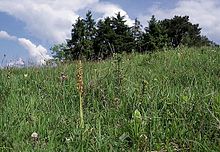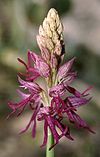No-horn
| No-horn | ||||||||||||
|---|---|---|---|---|---|---|---|---|---|---|---|---|

Sanshorn ( Orchis anthropophora ) |
||||||||||||
| Systematics | ||||||||||||
|
||||||||||||
| Scientific name | ||||||||||||
| Orchis anthropophora | ||||||||||||
| ( L. ) All. |
The orchis anthropophora ( Orchis anthropophora (L.) All. , Syn .: Aceras anthropophorum (L.) WTAiton ) is a type of the plant genus orchids ( Orchis ) within the family of orchids (Orchidaceae). The species was previously placed in the monotypical genus Aceras .
Surname
The botanical generic name is Orchis "testicles". The specific epithet anthropophora consists of the Greek words άνθρωπος anthropos “man, man” and φερείν pherein “to carry”.
The German name is Ohnhorn. Also very common is the name Ohnsporn , which refers to the missing spur. The names Hanging Man , Puppenorchis and Fratzenorchis allude to the "human-like" flower shape . In Italian usage, the plant has the beautiful name "Ballerina".
description
Habit and leaf
The Ohnhorn is a relatively delicate perennial herbaceous plant that reaches average heights of 20 to 40 centimeters. This geophyte forms relatively small, rounded, egg-shaped tubers as persistence organs. At the end of the flowering period, a new sprout forms from a daughter tuber, from which the leaves shoot in autumn. The plant survives the winter with green leaves; this feature indicates its Mediterranean origin (high winter precipitation in connection with little frost are favorable growth conditions for the plant).
The foliage leaves are approximated in rosettes in the lower part of the stem , while they surround the upper stem in a sheathed manner. The relatively many (about four to nine) shiny and vivid green leaves are elongated-lanceolate in shape.
Inflorescence and flower
The high, filigree inflorescence contains up to 100 flowers . The hermaphrodite flowers are zygomorphic and threefold. The flower size is 12 to 14 millimeters. The egg-shaped, red-edged sepals (sepals) and the slightly shorter lanceolate petals (petals) form a hemispherical helmet. The labellum (lip) is spurless, 12 to 15 millimeters long, drooping, greenish / ocher yellow to brownish / orange-red. The two tips of the middle lobe are a little longer than the side lobes. There are two typical calluses at the base of the lip . The adhesive discs of the pollinia are fused.
The flowering period of the Ohnhorn extends from the beginning of May to the end of June. After that, the plant, including the leaves, is quickly obsolete.
The number of chromosomes is 2n = 42.
ecology
The Ohnhorn is one of the few Central European orchids that are visited and pollinated by beetles and small click beetles. The spurless flower enables the beetles to access the nectar with their short mouthparts.
distribution
The Mediterranean, sub-Mediterranean, Atlantic area of distribution of the Ohnhorn extends from North Africa , Spain , the Balearic Islands over the entire Mediterranean area, including the islands to Lebanon . In Central Europe there are deposits in France to the south of England and the Alpine countries , but not in high mountain areas. According to Baumann and Künkele , the species occurs in the Alpine countries within the following altitude limits: Germany 80–2280 meters, France 1–2660 meters, Switzerland 260–2710 meters, Liechtenstein 470–2200 meters, Austria 350–2700 meters, Italy 80–2970 meters , Slovenia 90-2180 meters ahead. In Europe it rises to 2970 meters, in the Himalayas up to 3900 meters above sea level.
The Ohnhorn is a floral element of the Mediterranean, Central and West Sub-Mediterranean, South and Central Atlantic, South Sub-Atlantic Florence zones. It is one of the sub- Mediterranean representatives in the flora of Central Europe . It is one of the more inconspicuous native orchid species. In recent years a certain spread of this plant species has been observed in Central Europe.
In Germany there are scattered distribution areas in Baden-Württemberg (especially on the Upper Rhine ), Rhineland-Palatinate (especially on the Moselle and Eifel ), in Saarland and very rarely in North Rhine-Westphalia (extreme southwest), Hesse (northeast; Bergstrasse), South Lower Saxony , Bavaria ( Maintal region , Rhön ), isolated sites in Thuringia and Saxony-Anhalt .
In Austria the species is found in Lower Austria and Carinthia . In Switzerland , the ohnhorn occurs mainly in the cantons of the Swiss Jura and in the Rhone Valley.
Due to the mild winters of recent years, this species has been observed to spread to previously too cold areas.
Location
The Ohnhorn loves sunny hills, short- grass rough lawns and light bushes on dry to moderately fresh soils. This type of plant is limestone and extremely thermophilic by our standards . Therefore, the occurrence is limited to particularly warm places.
It is found in the plant communities, especially the Mesobrometum from the Mesobromion Association, but also occurs in the societies of the Geranion sanguinei association (for a breakdown see: Plant sociological units according to Oberdorfer ).
Conservation and endangerment
Like all orchid species found in Europe, the Ohnhorn is also subject to strict protection by European and national laws.
- Red list Germany: 3
- Red list federal states: Baden-Württemberg : 2, Bavaria : 1, Hesse : 3, North Rhine-Westphalia : 3, Rhineland-Palatinate : 2, Saarland : 3, Saxony-Anhalt : 1, Thuringia : 1.
- Not found in the other federal states or anointed (Lower Saxony).
- Red List Switzerland: VU (Vulnerable)
- Red list Austria: no information available.
The population development in Germany is increasing slightly. The losses due to site destruction are offset by some new discoveries.
Systematics
The botanically valid species name is Orchis anthropophora (L.) All. in Fl.Pedem. 2: 148, 1785.
In a 1997 revision of the orchid species by Bateman on the basis of genetic traits, the hornless horn was classified as Orchis anthropophora together with some other species in the genus Orchis ( Orchis ) . This name is sometimes already used as a valid new name (Kew-Garden), but has not yet been fully established and is not entirely undisputed even among experts (see notes in Orchis ustulata ).
In addition to the Basionym Aceras anthropophorum W.T. Aiton 1814, there are other synonyms based on the same type :
|
|
Subspecies, varieties, hybrids
| × Orchiaceras bivonae | × Orchiaceras spurium |
Neither subspecies nor varieties of the Ohnhorn are known, if the names of nomenclaturally irrelevant flower colors are dispensed with.
Aceras anthropophorum is very closely related to the Orchis militaris circle of shapes and hybridizes with its species: orchid orchid ( Orchis militaris ), Italian orchid ( Orchis italica ), purple orchid ( Orchis purpurea ) and monkey orchid ( Orchis simia ).
For example:
- × Orchiaceras bergonii (Nanteuil) EGCamus (Syn .: Orchis × bergonii Nanteuil ) = Orchis anthropophora × Orchis simia
- × Orchiaceras bivonae (death.) Soó (Syn .: Orchis × bivonae death. ) = Orchis anthropophora × Orchis italica
- × Orchiaceras meilsheimeri (Rouy) P. Fourn . (Syn .: Orchis × macra Lindl. ) = Orchis anthropophora × Orchis purpurea
- × Orchiaceras spurium (Rchb. F.) EGCamus (Syn .: Orchis × spuria Rchb.f. ) = Orchis anthropophora × Orchis militaris
Picture gallery
literature
- Standard literature on orchids
- Working groups local orchids (ed.): The orchids of Germany. Working groups of domestic orchids, Uhlstädt-Kirchhasel 2005, ISBN 3-00-014853-1 .
- Helmut Baumann , Siegfried Künkele : The wild growing orchids of Europe. Franckh, Stuttgart 1982, ISBN 3-440-05068-8 .
- Karl-Peter Buttler : Orchids. The wild growing species and subspecies of Europe, the Middle East and North Africa (= Steinbach's natural guide. 15). Mosaik, Munich 1986, ISBN 3-570-04403-3 .
- Robert L. Dressler: The orchids - biology and systematics of the Orchidaceae (original title: The Orchids. Natural History and Classification. Harvard University Press, Cambridge, Mass. Et al. 1981). Translated by Guido J. Braem with the assistance of Marion Zerbst. Bechtermünz, Augsburg 1996, ISBN 3-86047-413-8 (good work on the subject of systematics).
- Hans Sundermann : European and Mediterranean orchids. 2nd Edition. Brücke, Hildesheim 1975, ISBN 3-87105-010-5 .
- John G. Williams, Andrew E. Williams, Norman Arlott: Orchids of Europe with North Africa and Asia Minor (= BLV determination book. 25). Translated, edited and supplemented by Karl-Peter Buttler and Angelika Rommel. BLV, Munich / Bern / Vienna 1979, ISBN 3-405-11901-4 .
- Special literature on the absenteeism
- T. Blachnik-Göller: Aceras anthropophorum - first discoveries for Bavaria. In: Reports of the Bavarian Botanical Society. Volume 62, 1991, pp. 263-266 (PDF file) .
- E. Klein: The intrageneric hybrids of the genus Orchis and their intergeneric hybrids with the genera Anacamptis, Aceras and Serapias. In: Reports from the working groups for domestic orchids. Volume 6, No. 1, 1989, pp. 12-24.
- M. Kropf: Recent population development of (sub-) Mediterranean plant species: The distribution of the bald spur (Aceras anthropophorum [L.] AIT.) In the Nahe area (flora of Rhineland-Palatinate). In: Mainzer naturwiss. Archive. Volume 41, 2003, pp. 93-102.
- H. Schlagowski: Aceras anthropophorum (L.) AITON fil. and their bastards. In: Bulletin of the Working Group Native Orchids Baden-Württemberg. Volume 2, No. 6, 1970, pp. 81-88.
- N. Schlaich: A remarkable recovery after 45 years of Aceras anthropophorum (L.) WT AITON on the northern Bergstrasse. In: Reports from the working groups for domestic orchids. Volume 1, No. 1, 1984, p. 93.
- Special literature
- Richard M. Bateman, Alec M. Pridgeon, Mark W. Chase: Phylogenetics of subtribe Orchidinae (Orchidoideae, Orchidaceae) based on nuclear ITS sequences. 2. Infrageneric relationships and reclassification to achieve monophyly of Orchis sensu stricto. In: Lindleyana. Volume 12, 1997, pp. 113-141.
- Richard M. Bateman, Peter M. Hollingsworth, Julian Preston, Yi-Bo Luo, Alec M. Pridgeon, Mark W. Chase: Molecular phylogenetics and evolution of Orchidinae and selected habenariinae (Orchidaceae). In: Botanical Journal of the Linnean Society. Volume 142, No. 1, 2003, pp. 1-40, DOI: 10.1046 / j.1095-8339.2003.00157.x .
Individual evidence
- ^ Erich Oberdorfer : Plant-sociological excursion flora for Germany and neighboring areas . With the collaboration of Angelika Schwabe and Theo Müller. 8th, heavily revised and expanded edition. Eugen Ulmer, Stuttgart (Hohenheim) 2001, ISBN 3-8001-3131-5 , pp. 285 .
- ↑ a b Helmut Baumann , Siegfried Künkele : Orchidaceae . In: Oskar Sebald u. a .: The fern and flowering plants of Baden-Württemberg. 1st edition volume 8, page 356. Verlag Eugen Ulmer, Stuttgart 1998. ISBN 3-8001-3359-8
- ^ Karl-Peter Buttler: Orchids. The wild growing species and subspecies of Europe, the Middle East and North Africa (= Steinbach's natural guide. 15). Mosaik, Munich 1986, ISBN 3-570-04403-3 .
- ↑ Rafaël Govaerts (ed.): Orchis anthropophora. In: World Checklist of Selected Plant Families (WCSP) - The Board of Trustees of the Royal Botanic Gardens, Kew . Retrieved December 20, 2016.
Web links
- Aceras anthropophorum (L.) WT Aiton, Ohnsporn. In: FloraWeb.de.
- No-horn . In: BiolFlor, the database of biological-ecological characteristics of the flora of Germany.
- Profile and distribution map for Bavaria . In: Botanical Information Hub of Bavaria .
- Distribution maps
- Regional
- The orchids of the Rhön: Orchis anthropophora , Ohnsporn
- AHO Bayern: Aceras anthropophorum ( Memento from September 28, 2007 in the Internet Archive )
- Ruhr-Universität Bochum: Aceras anthropophorum ( Memento from June 14, 2007 in the Internet Archive )
- orchis.de: Aceras anthropophorum
- AGEO Switzerland: Aceras anthropophorum
- The orchids of Germany: Orchis anthropophora
- Nature Lexicon: Aceras anthropophorum
- Distribution map D at FloraWeb
- Formentera (Balearic Islands): Aceras anthropophorum
- "Orquídeas de Almería" picture series: Ohnhorn ( Aceras anthropophorum )
- see also













